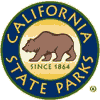|
REDWOOD
The Redwood State Parks |

|
REDWOOD COUNTRY
Coast redwoods "follow the fog," and grow best in areas of heavy winter rainfall, relatively moderate temperatures year round, and summers with little rain but lots of fog. Soils of the region are unstable, and this combined with the heavy rainfall and, occasionally, careless logging and other land use practices, has occasionally, led to destructive flooding, as in 1955 and 1964.
Fishermen flock to the redwood region — rainbow and cutthroat trout, steelhead, and salmon are common catches. On the margins of the forests live chipmunks, gray squirrels, Columbian black-tailed deer, black bear, and mountain lions — Roosevelt elk also live in the northern part of the range. Many species of birds — over 140 have been reported — including grouse, quail, duck, pigeon, hermit thrush, wren, and raven make the redwood forests their home.

|
| Fishing the streams of the redwood country is a popular pastime. (John Robinson) |

|
| Gold Bluffs Beach at Prairie Creek Redwoods State Park. (Department of Parks and Recreation) |
In many areas, the redwoods share the forest with other trees — Douglasfir, tanoak, madrone, big-leaf maple, red alder, California laurel (or pepperwood), California buckeye, Oregon oak, California black oak. In the spring, the western dogwood adds a touch of color to the forest with its striking white flowers, and year-round green is contributed in some areas by coast hemlock, Sitka spruce, and Port Orford cedar.
Not surprisingly, redwood-associated shrubs are usually shade loving. Often found are the California huckleberry, salal, varieties of ceanothus, thimbleberry, salmonberry, western azalea, the famed rhododendron — travelers often come hundreds of miles to see this shrub's springtime display — and a wide variety of mosses and lichens. Equally spectacular in the fall, when its leaves turn bright red, is the Rhus diversioba — poison oak. Other times of the year it is equally dangerous, but unfortunately less conspicuous. Delicate flowering plants and ferns, such as the five-finger fern which covers the walls of exquisite Fern Canyon at Prairie Creek Redwoods State Park, complete the forest scene.
Though the Sierra redwood lives in a more extreme, drier climate, where summer fog is almost unknown and most of the precipitation is winter snow, the shrubs and wildlife living in and near the groves are in many respects similar to those found on the coast. Associated trees include the sugar pine, white fir, ponderosa pine, black oak, big-leaf maple, and incense cedar.
| <<< Previous | <<< Contents>>> | Next >>> |
state-parks/sec5.htm
Last Updated: 14-Oct-2011